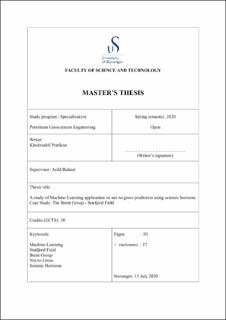| dc.contributor.advisor | Buland, Arild | |
| dc.contributor.author | Pratikna, Khoirrashif | |
| dc.date.accessioned | 2020-10-13T09:06:04Z | |
| dc.date.available | 2020-10-13T09:06:04Z | |
| dc.date.issued | 2020-07-15 | |
| dc.identifier.uri | https://hdl.handle.net/11250/2682385 | |
| dc.description | Master's thesis in Petroleum Geosciences Engineering | en_US |
| dc.description.abstract | As petroleum geosciences enter the era of big data, this field of study encompass difficult optimization and decision-making in real-world problems. The increasing number, difficulty, and scale of such specific problems has become too complicated for geoscientists to rely on a single discipline for effective solution. Machine Learning (ML) provides extensive capability to be the solution in this area.
This thesis, as a part of ongoing research, focuses on the application of various ML algorithms in predicting the net to gross value of the Brent Group reservoir zone in the Statfjord Field. For this purpose, several objectives were defined. As the first fundamental step, features were generated directly from the TWT and amplitudes of the respective seismic horizons. Secondly, predictive models were built from both training and testing phase using the features. The final task was estimating and mapping the value of net to gross property of the pre-defined reservoir zone. Furthermore, classification task and sand thickness prediction were also included as additional comparisons to the main task.
The results indicate outstanding performance demonstrated by Decision Tree and Random Forest algorithms despite the limitation on the dataset. Insufficient amount of data as well as data cleaning problems have been the main constraints in this study. This unarguably led to high variance in the data which yielded less accurate and less reliable prediction models.
The ML clearly have potential to accomplish the defined task better once the obstacles are handled properly in the future studies. Some improvements such as better data cleaning process, more involvement of well logs data, AVO inversion analysis, and utilization of more advance algorithms are strongly suggested in order to boost the models’ performance. | en_US |
| dc.language.iso | eng | en_US |
| dc.publisher | University of Stavanger, Norway | en_US |
| dc.relation.ispartofseries | Masteroppgave/UIS-TN-IER/2020; | |
| dc.subject | petroleumsgeologi | en_US |
| dc.subject | Statfjord Field | en_US |
| dc.subject | Brent Group | en_US |
| dc.subject | Net-to-gross | en_US |
| dc.subject | maskinlæring | en_US |
| dc.subject | machine learning | en_US |
| dc.subject | seismic horizons | en_US |
| dc.title | A study of Machine Learning application on net-to-gross prediction using seismic horizons. Case Study: The Brent Group - Statfjord Field | en_US |
| dc.type | Master thesis | en_US |
| dc.subject.nsi | VDP::Teknologi: 500::Berg‑ og petroleumsfag: 510::Geoteknikk: 513 | en_US |
| dc.subject.nsi | VDP::Matematikk og Naturvitenskap: 400::Geofag: 450::Petroleumsgeologi og -geofysikk: 464 | en_US |
